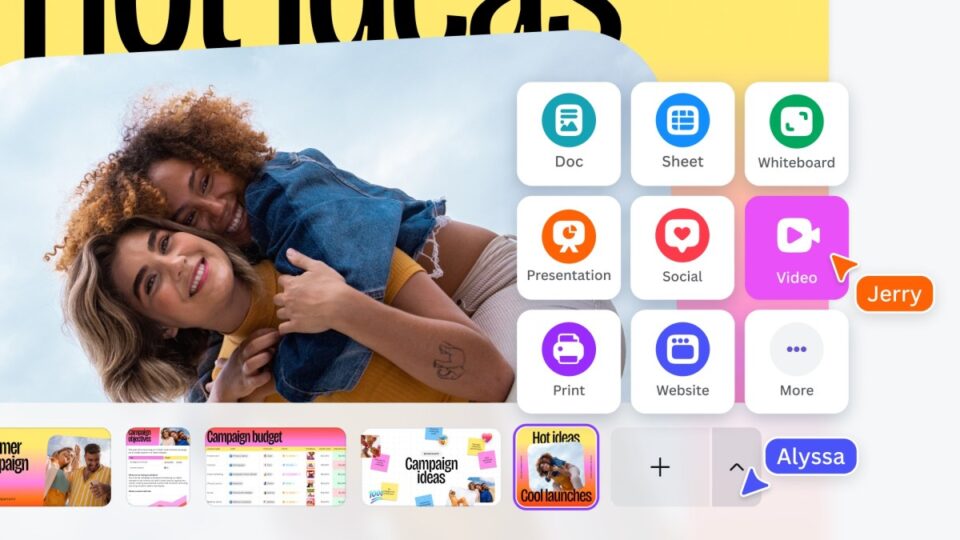Although there has been significant pushback from artists regarding the proliferation of AI design tools and the content used to train generative models, the companies making the software for creative work are nevertheless building AI into their toolkits. It’s a signal of just how quickly AI has gained importance — regardless of what their customers say, graphic design software makers clearly seem to think they cannot survive without implementing some form of AI.
The latest to double down on that strategy is Canva. The company on Thursday said it is adding a suite of new AI features to its platform, including an AI assistant, the ability to create apps with prompts, support for spreadsheets, and AI-powered editing tools.
Baking in AI
Called Canva AI, the company’s AI assistant can perform a host of tasks, from creating images according to your instructions, to coming up with design ideas — say, collateral for social media or mock-ups for printing. It can even write copy and create documents.
And by tapping into a new tool dubbed Canva Code, the assistant can also be prompted to create mini-apps, like interactive maps or custom calculators, that can then be integrated in designs. Canva has partnered with Anthropic for this feature, the Australian design company’s co-founder and chief product officer Cameron Adams told TechCrunch.

“Over the years, we have encouraged our teams to make interactive prototypes because static mock-ups don’t truly represent the experience we are trying to create with Canva for users. We started seeing teams inside Canva use AI a lot for prototyping. We thought of externalizing it and giving everyone the ability to code easily and create interactive experiences,” Adams said.
To be clear, Canva is not the first to do this. Several startups such as Cursor, Bolt.new, Lovable, and Replit have attracted lots of customers and attention for enabling users to prompt their way to creating applications. Still, Canva has an incentive to bake such a feature into its software, as it complements its broader selling point as a service used to design everything from marketing collateral to websites.

Canva is also adding new AI features to its photo editor: One tool allows users to point and click to modify artifacts in photos, while another is a background generator that accounts for lighting and layout. This feature set seems aimed at helping the company compete with tools like Adobe Photoshop, Adobe Lightroom, and Pixelmator (acquired by Apple last year).
For the enterprise
Last year, Canva launched an enterprise-focused product to better serve larger teams with features like single sign-on and access management tools. Now it’s adding spreadsheets to the mix with Canva Sheets.

Besides the usual spreadsheet features, Canva Sheets comes with a tool called Magic Insights, which, as it says on the tin, surfaces insights gleaned from data on the sheet. There’s also a feature called Magic Charts, which converts raw numbers into charts automatically, complete with brand-specific graphics and logos.
The company said Canva Sheets supports integrations with HubSpot, Statista, Google Analytics, and more to let users import data easily.
The artist vs. AI dilemma
Companies like Adobe, Canva, and Pixlr may be looking to add more value to their offerings, but the fact remains that bringing AI into design tools is causing some tension. Not only are artists worried about their work being used to train AI models without permission, but there’s also a real threat to creative design jobs.
Still, Adams doesn’t see this as a clash between AI and creativity; rather, he sees this as a moment of growth and opportunity in the field.
“I think all our jobs will change as AI comes, as different tools are integrated across every specialty, whether it be design, product management, engineering, marketing, or sales,” he said. “I think each job is going to change and adapt to the help they will get from AI tools. We just see a massive opportunity,” Adams said.
Those changes, it seems, will be here sooner than most expect. Earlier this month, the company laid off some technical writing staff, nine months after its co-founders reportedly asked employees to use AI apps wherever they could. Adams, however, said that these layoffs were not related to AI tools the company is building, but were an effect of restructuring.
Ivan covers global consumer tech developments at TechCrunch. He is based out of India and has previously worked at publications including Huffington Post and The Next Web. You can reach out to him at im[at]ivanmehta[dot]com
